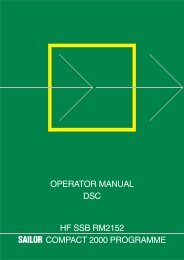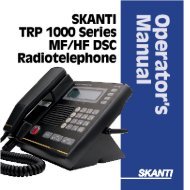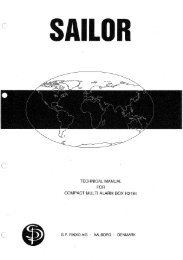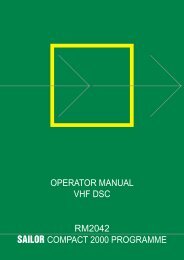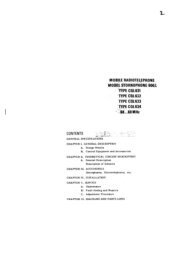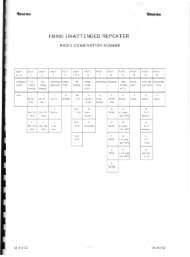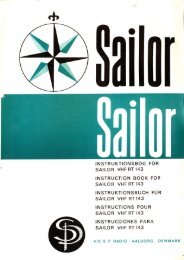TECHNICAL MANUAL FOR COMPACT VHF DSC RM2042
TECHNICAL MANUAL FOR COMPACT VHF DSC RM2042
TECHNICAL MANUAL FOR COMPACT VHF DSC RM2042
You also want an ePaper? Increase the reach of your titles
YUMPU automatically turns print PDFs into web optimized ePapers that Google loves.
1 INTRODUCTION <strong>RM2042</strong>1.4 PRINCIPLE OF OPERATION AND BLOCK DIAGRAMRECEIVERThe RF-signal from the antenna is feed to the input amplifier circuit. Here is the initial filtering made bymeans of a fixed, double tuned filter before the signal is amplified in the front-end amplifier. This amplifieris followed by another fixed, double tuned filter. The amplified and filtered signal is feed to the first mixerstage.This stage converts the received signal to the first IF frequency on 15.3 MHz. The local oscillator forthis stage is created by means of an XTAL oscillator running at 141.225MHz.The signal is filtered by means of an XTAL-filter, amplified and then feed to the integrated IF-circuit. Thiscircuit includes the second XTAL-oscilllator circuit running at 14.85MHz, the second mixer stage andfollowing limiting amplifiers and detector circuits.The filtering on the second IF-frequency at 450kHz, is made by means of a ceramic filter.The detected AF-signal is led through an electrical controlled switch, which is only used for loop backtest purpose. The output from this switch is filtered in the deemphasis filter, before the AF signal selection,where the selection between the build-in channel-70 receiver and the connected <strong>VHF</strong> radiotelephone isperformed.The switch setting of the AF selection is determined by the actual operation of the unit and signal strengthon Channel-70, giving full priority to the Channel-70 receiver output.From the connected <strong>VHF</strong>-radiotelephone, the detected AF-signal is feed to a deemphasis filter and acarrier detect circuit, which provides the needed signals for the demodulator when you are using the publiccall facilities.The selected AF-signal is furthermore feed to the interface board, where it is amplified to source aninternal loudspeaker.The FSK-modem performs the demodulation of the received FSK-signal, and the modulation of the AFsignalfor the transmitter. The circuit is controlled from the microprocessor board.Internal power supply for the board, is generated with two regulators, one for 5V and one for 10V.A power low condition is signaled from the 10V regulator to the microprocessor unit, to secure a controlledpower down sequence.INTERFACEThis module provides the necessary connections between the modules and between the modules andthe externally connected equipment, such as power supply, <strong>VHF</strong>-transceiver, telephone handset, printeretc.This unit must be supplied with 12V DC, which can be provided either directly from batteries or from N420,24 to 12V converter. The proper operation of the ON/OFF switch is selected by means of the 12/24V wiringcircuit.Fuse and over/reverse-voltage protection is placed on this module as well.The 5V power supply for internal digital boards are made on this unit.The AF power amplifier for the loudspeaker is supplyed by its own 5V regulator and the AF comes fromthe receiver module. Alarm and mute signals are generated on the microprocessor module and feed tothe amplifier chain.Distress channel information for a connected scrambler, is buffered and level shifted, before it is feedto the 9-pole connector.AF output for the connected transmitter is buffered and level adjusted in different amplifiers.When the unit is operating in an automatic system with a <strong>VHF</strong>-transceiver, is the AF output deliveredas an unbalanced signal adjusted in level to fit the microphone input sensitivity of the transceiver.When the unit is operating as a <strong>DSC</strong>-encoder is the AF output port swiched to supply the signal on a 600ohm balanced output port. The level can be adjusted to 0dBM 10dB by means of a trimmingpotentiometer.When the <strong>VHF</strong> port communication switch is set for an automatic system, the serial communication linkto the transceiver will be connected to the 9 pole output connector for the <strong>VHF</strong>.The remaining circuits on this module consists of input buffers and level shifters for the i/o links to themicroprossor. These links are used for the NMEA interface, printer interface and the interface to C2149,remote distress unit, or a PC for programming or remote control.PAGE 1-6





